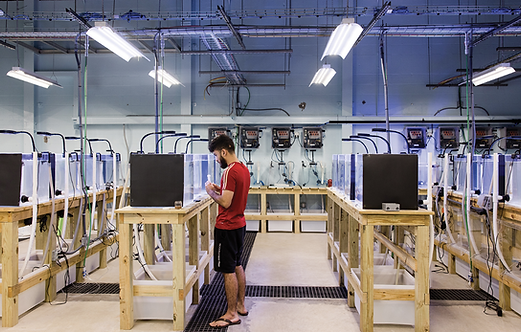
Previous Projects
Fish communities on remnant and restored oyster reefs of East and Escambia Bays: a baseline for assessing restoration success
PI: Ronald Baker
Duration: Fall 2021 - Spring 2022
Funding: Pensacola and Perdido Bays Estuary Program
Healthy oyster reefs provide a variety of ecosystem services that benefit coastal communities and beyond. They support oyster fisheries, improve water quality, and provide important habitats for a diversity of species, including many fisheries species of great social and economic importance. Significant oyster restoration projects continue in the Pensacola Bay system, and the enhancement of fish habitat is a key goal of many projects. However, sampling fish communities on oyster reefs is challenging. This project uses underwater video to describe the fish communities on remnant and restored oyster reefs in East and Escambia Bays. By describing and comparing the fish communities among oyster reefs with different restoration status, depth, substrate type, and locations within the bays, we are identifying the drivers of variation in fish community composition among reefs and across the bays. Evaluating the success of existing restoration projects at enhancing fish habitat is a critical component of guiding future restoration efforts that wish to maximize fish habitat benefits, and returns on restoration investment. Understanding the current fish communities and their responses to restoration efforts will help maximize the health of the Bay's ecosystems, and fishing opportunities for coastal communities around Pensacola Bay.

We used GoPros affixed to weighted base-structures and float lines to record our underwater video for analysis

Lab intern Kelsey preparing to deploy a camera at a site in East Bay
Building Resilience to Environmental Trends and Variability for Oysters, Blue Crabs, and Spotted Seatrout in the Gulf of Mexico
Investigators: PI: John Lehrter (USA/DISL). Co-PI’s: Ronald Baker (USA/DISL), Just Cebrian (MSU/NGI), Brian Dzwonkowski (USA/DISL), Latif Kalin (Auburn), Lisa Lowe (NCSU), Dan Petrolia (MSU), Sean Powers (USA/DISL), Di Tian (Auburn), Seong Yun (Auburn).
Duration: September 2019 - August 2024
Funding: NOAA RESTORE
The abundance of key fisheries species like oysters, blue crabs, and spotted seatrout has declined in the Gulf of Mexico. These species have proved to be invaluable assets by providing nutritional food, community recreation, and cultural resources. Today, the ecosystem services provided by these key species are threatened or near collapse in Gulf estuaries. This is partially due to human activities and environmental trends such as fisheries harvest and changes in water and habitat quality. However, many underlying mechanisms that relate to long-term trends and short-term variability in the environment are unknown or unquantified regarding the changing populations of oysters, blue crabs, and spotted seatrout. This project identifies temperature, salinity, oxygen, and pH thresholds for oyster, blue crab, and spotted seatrout populations in Mobile Bay, Alabama. Current and future habitat conditions, including climate variability and human-induced stressors, are the basis of these thresholds.
The Baker Lab is leading four separate efforts on this project. The first is an assessment of long-term drivers of community dynamics using a 40-year historic dataset of nekton abundance to assess trends and potential correlations with environmental conditions. The second sub-project examines drivers of variation of growth of spotted seatrout and other fisheries species with consideration of environmental barriers and prey abundance as potential drivers. The Baker lab is also analyzing the historic production of key fisheries species in different regions to forecast shifts in productivity. Lastly, the Baker Lab will assess the relative importance of critical nursery habitats for blue crabs, spotted seatrout, and other fisheries species. The end products of this project include predictive models of fisheries species production and growth, a reassessment of key nursery habitats, and identifications of the key environmental drivers influencing fisheries species and overall nekton communities in coastal Alabama.

Ph.D. student, Hannah, poses with a spotted seatrout at the Alabama Deep Sea Fishing Rodeo. The Baker Lab collected otoliths from this species to assess their growth rates.

Master's student, Matheus, feeding juvenile spotted seatrout as part of a multistressor experiment held in DISL's new wet lab.
Photo by Elizabeth Gelinaeu, Mobile Bay Magazine.

Ronnie leads a drop sampling field day.
Living Shorelines: Does Breakwater Design Matter to Fish?
PI’s: Ronald Baker and Sarah Ramsden (USA/DISL).
Duration: Spring 2022 - Spring 2024
Funding: Mississippi-Alabama Sea Grant Consortium, Bullard Fund (USA).
Little Bay and the surrounding seascape off the coast of Bayou la Batre, Alabama, offer a unique opportunity to study sportfish movements around Living Shorelines. Within the home range of individual fish are three different coastal restoration projects that employ five different breakwater structure types, including man-made loose-shell oyster reefs, concrete wave attenuation pyramids (WADs) near and far from shore, mini-WADs, and riprap breakwaters. We are using fine-scale acoustic telemetry, in which arrays of closely spaced acoustic receivers triangulate the exact coordinates of tagged fish positions, within a broader tracking array to monitor sportfish use of breakwater structures, the habitats those structures protect, and the broader seascape. Currently, we are monitoring red drum, sheepshead, speckled trout, and southern flounder. We will also tag sharks to determine how sportfish habitat use changes in the presence of predators. This work will help to identify living shoreline features and breakwater types that are most attractive to important sportfish in order to potentially guide the design of future shoreline protection projects that seek to maximize fish-habitat benefits.
_HEIC.png)
Ph.D. student, Sarah, and M.S. student, Kelsey, downloading receiver data.


Sarah releases tagged fish within an acoustic receiver array.
